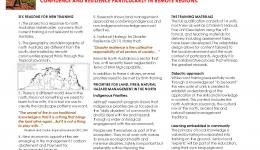Lead end user
Children represent the most vulnerable demographic group in disasters – across the globe it is estimated that 30-50% of fatalities are children - while they are also most vulnerable to psychosocial impacts. Early research indicates that children are a resource for reducing current disaster risks and can also mitigate future risks.
The role of children’s disaster education in managing risk has been recognised as a major priority in the federal government’s National Strategy for Disaster Resilience. Yet, despite a recent surge in child-centred disaster research, the social, psychological, economic and political mechanisms that enable children to both understand and take action to reduce disaster risk remain largely unexplored and the evidence-base for best-practice remains limited.
This project is conducting a nationwide evaluation of programs and strategies based on a child-centred disaster risk reduction framework. It will develop cost-effective programs that reduce the risk and increase resilience for children, schools, households and communities.
Resources credited
| Type | Released | Title | Download | Key Topics |
|---|---|---|---|---|
| HazardNoteEdition | 14 Jun 2016 | What is disaster resilience and how can it be measured? |
|
communities, indigenous communities, resilience |
| Presentation-Slideshow | 03 Jul 2015 | Northern Queensland Fire Season Potential Outlook |
|
fire, forecasting |




